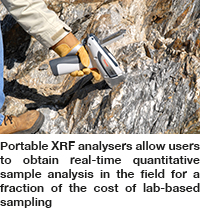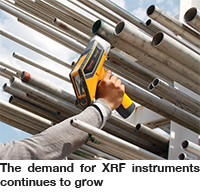Increased demand for XRF analyser hire
17/05/2016
 Steve Drake, NDT Market Manager at Ashtead Technology, believes that XRF is one of the most important technologies in the company’s fleet of NDT and environmental testing instruments. “With a small amount of training, almost anyone can implement detailed inspections in a wide variety of applications, and with most instruments being lightweight and robust, XRF analysers are among the most popular rental items,” he said. “We have therefore invested in a selection of the leading XRF equipment so that customers are able to choose the instrument and mode that best suits their application.”
Steve Drake, NDT Market Manager at Ashtead Technology, believes that XRF is one of the most important technologies in the company’s fleet of NDT and environmental testing instruments. “With a small amount of training, almost anyone can implement detailed inspections in a wide variety of applications, and with most instruments being lightweight and robust, XRF analysers are among the most popular rental items,” he said. “We have therefore invested in a selection of the leading XRF equipment so that customers are able to choose the instrument and mode that best suits their application.”X-ray fluorescence (XRF) analysers enable the chemical, non-destructive analysis of metals and alloys in a wide variety of materials. A simple point-and-shoot method means that even relatively inexperienced users can analyse metal content quickly and easily, following the requisite introductory course that is provided by Ashtead Technology’s Radiation Protection Supervisor, Will Russell.
 Highlighting the flexibility of these instruments, the Niton XL2, for example, offers a wide variety of modes for measuring metal content in different applications, including general metals, precious metals, soil metals, metals in mining materials, lead in paint and metals in catalytic converters, plastics and electronics. Within each of these modes, the XRF analyser is able to provide fast, accurate readings for a large number of metals.
Highlighting the flexibility of these instruments, the Niton XL2, for example, offers a wide variety of modes for measuring metal content in different applications, including general metals, precious metals, soil metals, metals in mining materials, lead in paint and metals in catalytic converters, plastics and electronics. Within each of these modes, the XRF analyser is able to provide fast, accurate readings for a large number of metals. One of the most common applications for XRF is positive material identification (PMI), which is an integral part of process safety management in a range of industries, including the petroleum refining and petrochemical industries. In response to a series of accidents resulting from material mix-ups, many companies have instituted stringent PMI programmes. Industry organisations have also worked to develop guidelines to ensure that the nominal compositions of all alloy components are consistent with design specifications.
Laboratory analysis of raw materials and process materials incurs a delay and extra cost, whereas portable XRF analysers are able to provide a quick, accurate screening method coupled with a pass/fail display and data logging with encryption to ensure the validity of data. Furthermore, instant certificates of compliance are made possible with the ‘NDT software’, which is supplied with the analysers free of charge.
Recycling has become a large industry and elemental analysis of waste metal is key to the determination of its value, so XRF analysers are commonly employed in this sector. Furthermore, the Waste from Electrical and Electronic Equipment (WEEE) Directive aims to reduce the amount of electrical/electronic equipment being produced and to encourage reuse, recycling and recovery. Again, elemental analysis has a role to play in the identification of mercury in some switches, lead in solder and cadmium in batteries. Similarly, organisations involved in plastic recycling and recycled polymer materials need to ensure they are not distributing materials with illegal cadmium levels.
The EU Directive on the Restriction of Hazardous Substances (RoHS) holds electrical and electronic equipment companies directly responsible for ensuring their products conform to its strict standards, preventing unacceptable levels of elements such as lead, cadmium, mercury and hexavalent chromium. XRF analysers are therefore employed by quality control staff within manufacturing industries to screen both imports and exports. XRF analysers are also commonly employed in quality control during the manufacture of products that contain metals and in the manufacture of products, such as toys, packaging and containers, that should not contain certain metals.
Environmental applications for XRF include the elemental analysis of materials such as bulk powder, surface dust wipes, lead in paint, air sampling filters and individual operator respirator filters. However, the most high-profile environmental application is the assessment of contaminated land. Portable XRF analysers are employed in remediation work to guide earth-moving equipment to soil contamination ‘hot-spots’, which results in less soil removal and thereby lowers costs. These instruments can perform both in-situ (on site) and ex-situ soil analysis (analysing prepared soil samples via the prepared sample test-stand and soil sample preparation kit). This reduces the costs and time incurred by laboratory analysis.
Summarising, Steve Drake said: “As customers find new ways to utilise XRF technology, the demand for these instruments continues to grow and, with the benefit of our in-house training, new users are able to operate safely and provide reliable measurements.”
www.ashtead-technology.com